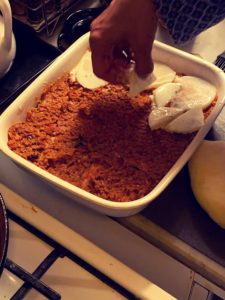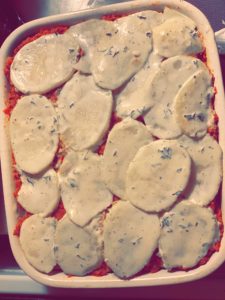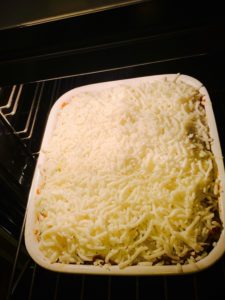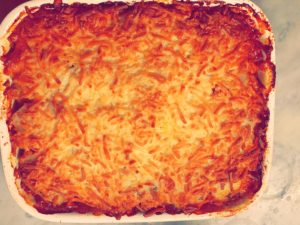The streets of Athens have a way of speaking to the wanderer; through their aromas, sounds, and textures. Yet, sometimes, one is led not by the sights, but by the wafting scent of something extraordinary, a dish so steeped in history that every layer is a chapter from an ancient manuscript: Moussaka.
At a corner taverna, an old man – Costas – noticed my foreignness and beckoned me over. As I sat down, a richly aromatic dish was placed before me. My first glimpse of moussaka – an alluring layer of golden bechamel sauce covering juicy minced meat sandwiched between soft, charred aubergines. Costas, noticing my obvious curiosity, began recounting its story.
“Every family in Greece has their version of moussaka,” he started, his voice gruff but eyes twinkling. “But like many tales, its origin isn’t solely Greek.”
The Byzantine Empire’s expansion brought numerous cultures under its vast wingspan, and with them, their culinary practices. The Arabs, having mastered the art of cooking aubergines, introduced the Greeks to a primitive form of what we now know as moussaka. It was a simpler dish then, with layers of aubergine and spiced meat, sans the luscious béchamel.
Costas leaned in, “But you see, moussaka was not just a dish; it was a bridge. As empires rose and fell, moussaka traveled, gathering elements from every land it touched.”
The Ottomans brought it further nuances. They introduced a variety of spices, enhancing its richness. However, it was the Greeks who, in their characteristic style, turned it into a culinary masterpiece. They crowned it with the béchamel sauce, giving it that creamy finish that balanced out the robustness of the meat.
“But Anthony,” Costas paused, using my name as if we were old friends, “You must understand, moussaka is not just food. Here, in Greece, it’s a testament. A testament to resilience, to the blending of cultures, and to the belief that from turmoil and chaos can emerge something beautiful.”
The evening wore on, and as the sun cast its golden hue over the Acropolis, I took another bite, letting the complexity of its history melt in my mouth. The creamy béchamel, the tang of the tomatoes, the earthiness of the aubergines – they weren’t just ingredients; they were stories, tales of conquests, and tales of homecomings.
As the taverna slowly emptied, Costas shared his family’s moussaka recipe, each ingredient annotated with a historical footnote. It wasn’t just a recipe; it was a timeline, a memoir.
Leaving Athens, I carried with me not just the memory of its taste but its tale. The moussaka, in its layered glory, is a dish that refuses to be pinned to one culture or era. It’s an evolving narrative, an ode to the age-old tradition of sharing and assimilating. It’s a dish that speaks of empires, of wanderers, and most importantly, of home.
Every time I savor moussaka now, I’m transported back to that Athenian taverna, to the tales of Costas, and to the realization that sometimes, history is best understood not through books but through flavors, one delicious layer at a time.
Moussaka
Ingredients
- For lamb/mutton mince 1/2 kg
- 2 onions medium-sized
- 1 cup yoghurt
- 4-5 cloves of garlic
- Thumb size piece of ginger
- 1 green chilli
- 1 cup tomato crushed
- 1/2 cup chopped coriander
- 2 tbsp tomato ketchup
- 1 tsp each Salt, chili powder,
- 1 1/2 tsp garam masala
- 1/2 tsp turmeric
- I stick cinnamon
- 2-3 tbsp oil
Directions
- For the layers: 2 large potatoes, parboiled.. in a cooker, cover with water and cook till almost coming to whistle. Or, In a pan, boil till you feel 5 more minutes and they will be soft-boiled. Basically, till the top is a bit soft, but the center still resists a poking knife/ fork. 1/2 cup cooking liquid cream, seasoned with salt, pepper, and any dried herb. 1 eggplant, sliced and 1 cup shredded cheese.
- Minced Meat: In a pressure cooker, Mix ginger garlic paste in yogurt, add chili powder, turmeric, garam masala powder, 1 tbsp oil, and cinnamon stick, and leave aside for a bit.
- Pressure cook it to one whistle, no water is to be added. Yogurt and mince oil are enough.
- In a wok, add the rest of the oil, add chopped onions, and fry till the edges get brown. Add mince mix from the cooker and fry, add tomatoes, and add salt, and coriander when the mutton is cooked and done. Can add a bit of warm water while cooking, but not to make a gravy. Add tomato ketchup and let it cool.
- Layering: In a baking dish, start with a thin layer of cooked minced mutton, Dip slices of potato in seasoned cream and layer. Then a layer of eggplant slices
Repeat in that order. Potatoes on top layer, add shredded cheese on top. - Bake in moderate oven for 30 mins / until brown on top.









